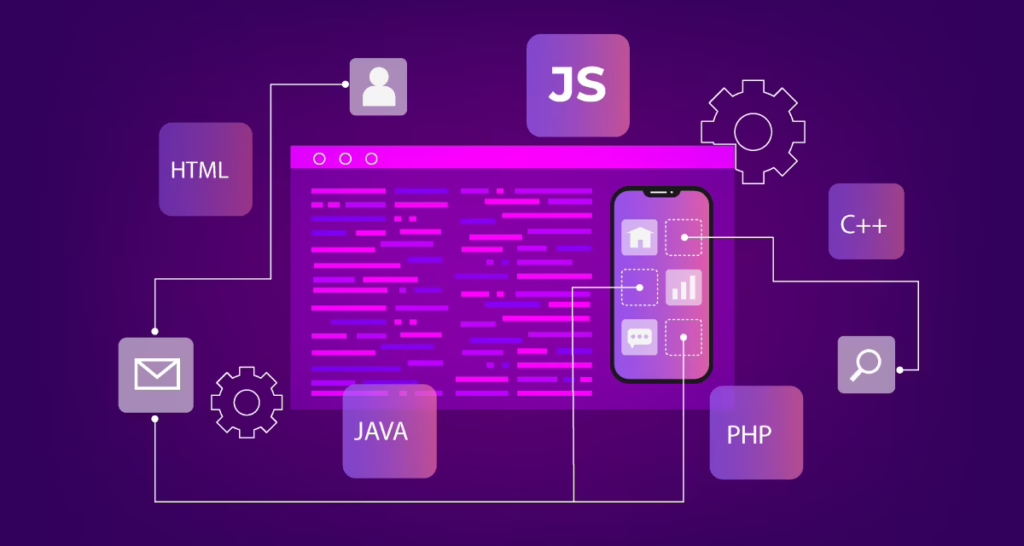Nowadays, Node.js web development has become a top choice for creating fast, scalable, and efficient applications. As a powerful platform for server-side programming, Node.js enables developers to build robust applications with JavaScript, extending its versatility from client-side to backend development. In this guide, we’ll explore what Node.js is, its unique advantages, and how it powers some of the most popular web applications in 2024.
Whether you’re considering web app development with Node.js or aiming to integrate it into your technology stack, this guide will offer comprehensive insights into the potential of Node.js.
Table of Contents
What is Node.js?
Node.js is an open-source, cross-platform runtime environment that allows developers to execute JavaScript code outside of a web browser. Built on Chrome’s V8 JavaScript engine, it provides a powerful, event-driven model that enables asynchronous programming. This is especially beneficial for Node.js backend development, as it helps manage multiple requests simultaneously without blocking processes.
Node.js was initially developed to help developers leverage JavaScript for server-side tasks. It has since evolved, becoming a popular choice in full-stack web development using Node.js, allowing developers to maintain a unified language across both client and server.

How Does Node.js Benefit Web Development?
Node.js offers several benefits that make it ideal for web development. Its non-blocking, event-driven architecture is designed to handle concurrent connections efficiently, which is crucial for scalable applications. Here are some core ways Node.js supports modern web development:
1. High Performance
Node.js is optimized for speed and efficiency, making it particularly advantageous for data-intensive applications that require fast processing. Built on Google’s V8 JavaScript engine, Node.js can compile and execute JavaScript at lightning speeds. Here’s why Node.js excels in performance:
- Event-Driven Architecture:
Node.js’s asynchronous nature allows it to handle I/O operations efficiently. Unlike traditional server models that may process requests one at a time, Node.js can execute multiple requests simultaneously without waiting for each to complete. This model is ideal for real-time applications like messaging apps, gaming servers, and live-streaming platforms.
- Single-Threaded Event Loop:
The event loop in Node.js enables it to manage multiple clients at once. Rather than creating new threads for each client, Node.js processes requests on a single thread using an event loop, which avoids the overhead associated with traditional multi-threading. This makes Node.js incredibly responsive and resource-efficient.
- Minimal Latency:
Node.js’s non-blocking I/O operations significantly reduce latency, which is crucial for real-time web applications that require instant data updates. This makes Node.js a great choice for applications that need immediate feedback and data synchronization, such as collaborative tools and online chats.
With these performance-driven features, Node.js is an excellent choice for businesses needing fast, responsive applications, especially in fields like streaming data and real-time communication.
2. Scalability
Scalability is a crucial requirement for modern web applications, especially as user demand and data loads increase over time. Node.js’s design offers robust scalability options that help web applications handle growth effectively. Node.js supports both horizontal and vertical scaling, making it highly adaptable for web app development projects of varying sizes.
- Horizontal Scaling:
Node.js allows developers to add more servers or nodes to distribute the load, making it easy to handle larger volumes of requests. This approach is particularly useful for applications experiencing rapid growth in user base or traffic.
- Vertical Scaling:
In addition to horizontal scaling, Node.js supports vertical scaling, meaning it can increase the capacity of a single server to handle more tasks. This flexibility helps developers optimize their infrastructure without the need for complex architecture changes.
- Microservices Architecture:
Node.js is well-suited for a microservices architecture, where the application is divided into smaller, independent services that communicate with each other. This structure enables teams to scale specific parts of an application as needed and manage workloads more effectively. As a result, each service can be developed, tested, and deployed independently, accelerating development cycles.
- Cluster Module:
Node.js’s built-in cluster module enables applications to take advantage of multi-core systems by spawning multiple processes. This allows applications to balance the load and improve response times by efficiently distributing tasks across CPU cores.
With these scaling features, Node.js can support a wide range of web applications, from startups building MVPs to enterprises managing millions of users.
3. Unified Codebase
This unified approach offers numerous benefits, particularly in full-stack development:
- Seamless Communication:
By using JavaScript across the entire stack, Node.js eliminates language barriers between frontend and backend development. This makes communication between developers easier, leading to more cohesive, efficient projects.
- Reduced Learning Curve:
Developers can work across the stack with a single language, reducing the learning curve. This is particularly beneficial for small teams or projects where resources may be limited, as developers don’t need to learn multiple languages to contribute to both frontend and backend tasks.
- Efficient Resource Allocation:
With Node.js, teams can allocate resources more flexibly. Developers skilled in JavaScript can contribute to various parts of the project, reducing the dependency on specialized developers and enabling faster development cycles.
- Code Reusability:
Node.js promotes code reusability across the frontend and backend. For instance, modules and functions written for the backend can sometimes be reused on the frontend, saving development time and ensuring consistency.
This unified codebase is especially beneficial for RESTful API development with Node.js, where the same language can be used to handle both client and server requests seamlessly. The result is faster development, simplified debugging, and streamlined collaboration across teams.
Whether for RESTful API development with Node.js or creating complex web applications, these benefits make Node.js an exceptional platform for web developers worldwide.
Key Features of Node.js for Web Development
Node.js has an array of features that make it a powerful choice for web app development in Singapore and globally. Let’s look at some of the most significant ones:
- Asynchronous and Event-Driven: Node.js uses non-blocking I/O, making it highly efficient in handling tasks concurrently. This feature is invaluable for applications with a high volume of network requests.
- V8 Engine: Node.js is built on Google’s V8 JavaScript engine, known for its speed and efficiency. This allows for faster execution of JavaScript code, which is essential in high-demand applications.
- Single-Threaded Model with Event Loop: The single-threaded event loop model in Node.js manages multiple clients at once, making it ideal for scalable applications.
- NPM (Node Package Manager): NPM is the largest package ecosystem globally and provides thousands of libraries and tools. These tools help developers avoid reinventing the wheel and speed up development.
- Cross-Platform Compatibility: Node.js runs on all major operating systems (Windows, macOS, Linux), allowing for versatile development environments.
These features make Node.js an optimal choice for various web app development scenarios, whether you’re building an interactive single-page application or a full-stack web application.
Advantages of Node.js Web Development
The advantages of Node.js in web development extend beyond technical features, providing a wide array of business and operational benefits:
- Fast Execution and Development: Node.js’s asynchronous nature and V8 engine speed up both the execution and development processes, reducing time-to-market for applications. Actually, Node.js reduces development time by up to 30%.
- Single Language for Full-Stack Development: With full-stack web development using Node.js, developers can use JavaScript on both frontend and backend, simplifying communication between teams and reducing the need for multiple skill sets.
- Rich Ecosystem with NPM: With NPM, developers gain access to pre-built modules, cutting down on development time and enabling the quick addition of features like authentication, logging, and data management.
- Real-Time Data Handling: Applications built with Node.js excel at handling real-time data. This is crucial for applications like online chat apps, collaboration tools, and live-streaming services.
- Community Support: Node.js has a large, active community that continuously contributes to the platform’s ecosystem, offering support, libraries, and resources. In fact, Node.js is the most-used framework among software developers worldwide.
These advantages make Node.js a preferred choice for companies seeking robust solutions for Node.js backend development.
Disadvantages of Node.js Web Development
While Node.js offers numerous benefits in web development, it’s essential to understand its limitations to make informed decisions:
- Single-Threaded Nature: Although the single-threaded model is efficient, it can become a limitation when dealing with CPU-intensive tasks, such as complex computations and data processing.
- Callback Hell: Due to its asynchronous nature, Node.js can lead to complex nested callbacks, known as “callback hell.” This makes the code harder to read and maintain, although techniques like async/await and Promises can help.
- Less Mature Ecosystem for Some Areas: While NPM offers a vast library, certain enterprise-grade tools and libraries are more mature in other languages, such as Java or Python.
Despite these challenges, Node.js remains a valuable tool in the web development arsenal, especially when used appropriately for server-side programming and real-time applications.
Notable Examples of Successful Node.js Web Applications
Many high-profile companies rely on Node.js web development for their backend systems, showcasing its robustness and scalability. Here are some notable examples:
- Netflix: Node.js enables Netflix to handle a vast amount of user data and improve response times, providing a smooth user experience for millions worldwide.
- LinkedIn: LinkedIn switched to Node.js to enhance its mobile backend, improving performance while reducing the required resources.
- Uber: With its need for real-time data updates, Uber uses Node.js to handle massive amounts of geolocation data with minimal latency.
- PayPal: Node.js helped PayPal unify its engineering teams, enabling both frontend and backend developers to work with JavaScript, which sped up the development process.
These examples highlight the versatility of Node.js web development and demonstrate its reliability for high-demand applications.

How is Node.js Different from JavaScript on the Web?
While JavaScript powers the client side of web applications, Node.js extends its capabilities to the backend. Here are some critical differences:
- Execution Environment: JavaScript runs in the browser, while Node.js runs on the server, enabling it to handle requests, manage databases, and perform tasks outside the scope of frontend JavaScript.
- Modules and APIs: Node.js comes with a different set of modules compared to browser JavaScript. For example, it includes a file system and network modules, which are inaccessible to frontend JavaScript.
- Asynchronous Programming: While JavaScript in the browser has asynchronous capabilities, Node.js is specifically optimized for handling asynchronous operations server-side, making it ideal for scalable, real-time applications.
These distinctions emphasize the power of Node.js as a backend solution, making it invaluable for web app development with Node.js and RESTful API development with Node.js.
Conclusion
Node.js has transformed the way we approach web development, offering a powerful, flexible environment for building scalable and high-performance applications. Whether for real-time applications, complex single-page apps, or RESTful API development with Node.js, it provides the tools developers need to succeed in a competitive environment. If you’re ready to bring your web app idea to life with Node.js, consider partnering with Vinova.
Our team specializes in Node.js web development, ensuring your project is optimized for performance, scalability, and user engagement.